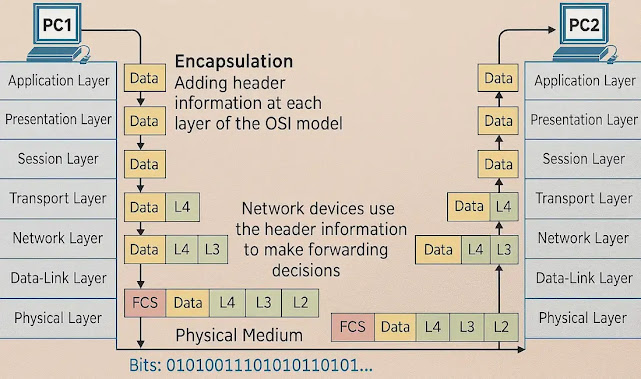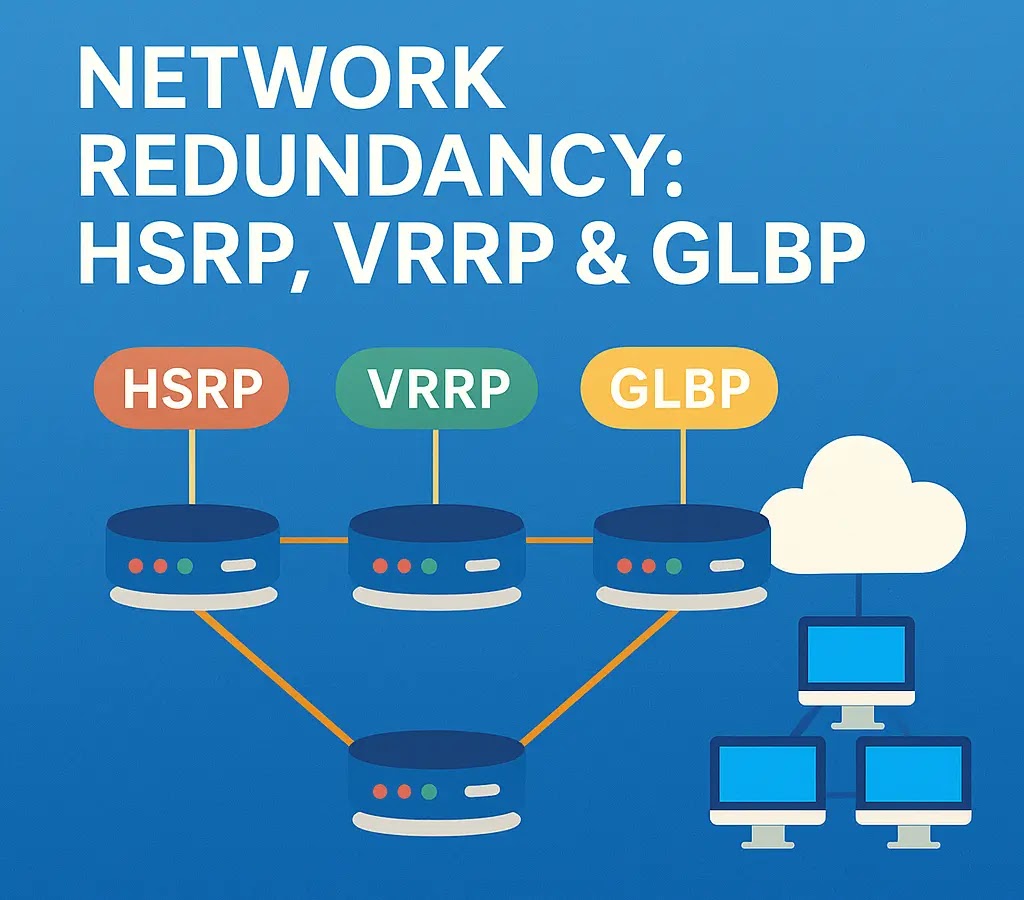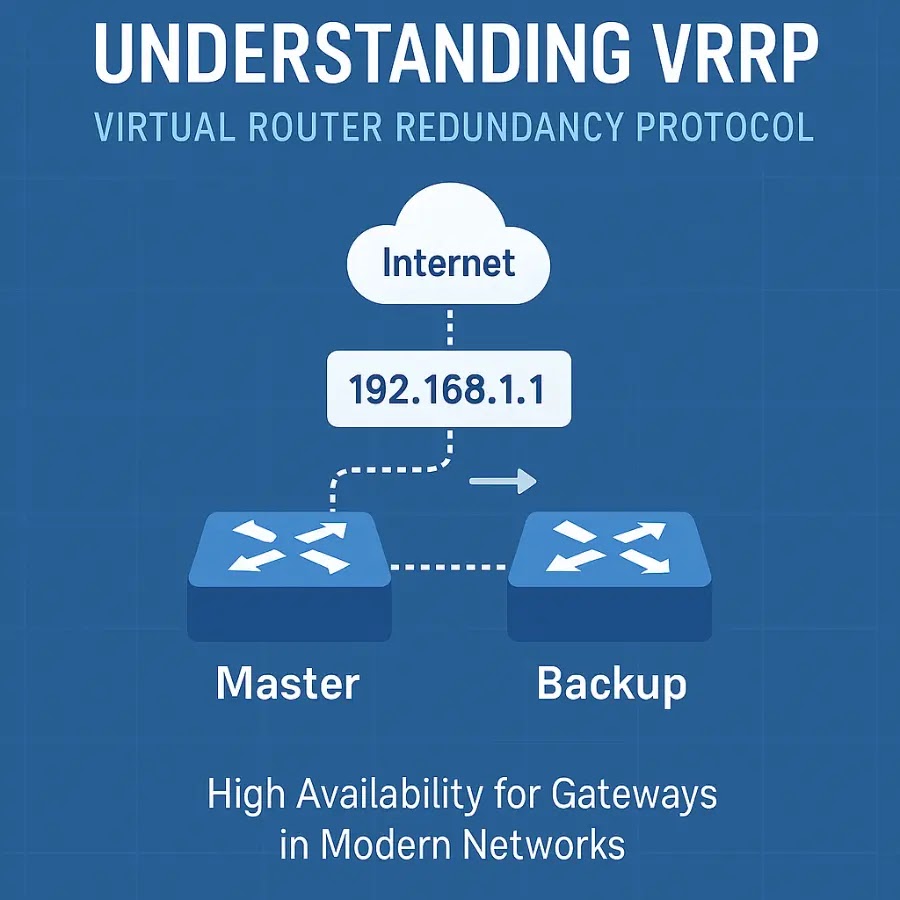In today’s networks, maintaining uptime and ensuring continuous access to network resources is critical. One point of failure often overlooked is the default gateway. That’s where Hot Standby Router Protocol (HSRP) comes in — providing gateway redundancy and enhancing network resilience.

✅ Introduction to HSRP
HSRP is a Cisco proprietary First Hop Redundancy Protocol (FHRP) designed to eliminate the single point of failure at the default gateway level. It allows a standby router to take over if the primary one fails.
Use case: Without HSRP, a router failure can break connectivity for all users relying on it as the default gateway.
🌐 HSRP Terminology and Concepts
- Active Router: Forwards traffic for the virtual IP.
- Standby Router: Backup router in case the active fails.
- Virtual IP: IP address used by clients as gateway.
- Virtual MAC: Automatically assigned MAC for the virtual IP.
- Priority: Higher value wins the election.
- Preemption: Allows router with higher priority to take back active role.
- Group Number: Identifier for HSRP group.
- Hello/Hold Timers: Control failover timing (default 3/10 seconds).
🔁 How HSRP Works
HSRP creates a virtual IP shared by routers. One becomes Active, another becomes Standby, and the rest listen. HSRP monitors router health using hello messages.
➡️ HSRP State Transitions (Detailed)
🔹 Initial
This is the starting state of the router when the HSRP process initializes (e.g., router just powered on or interface just came up). The router has not yet received or sent any HSRP hello messages. It does not know the virtual IP address, MAC address, or role in the group. The router is essentially waiting to learn HSRP configuration or participate in the group.
🔹 Learn
In this state, the router learns the virtual IP address and other HSRP parameters from received hello packets (if it hasn’t been configured manually). It does not yet know the active or standby routers. If a router joins an HSRP group but is not explicitly configured with a virtual IP, it will wait in this state until it learns it dynamically from an active router.
🔹 Listen
The router has the necessary HSRP group information and is listening for hello messages from active and standby routers. It is not actively participating in the election or forwarding traffic. It is essentially in a passive observer role, ready to act if needed. This state is also used by routers not designated as active or standby (in multi-router environments).
🔹 Speak
The router begins to send hello packets to advertise its presence. It participates in the active/standby router election process. If configured with a higher priority and preemption enabled, it can assert itself as the new active router. This is the state where the router makes its candidacy known to others in the group.
🔹 Standby
The router is selected as the backup router and will take over if the active router fails. It continues to monitor hello packets from the active router. If it stops receiving hello packets (based on the hold timer), it transitions to Active. The standby router is in a ready state, meaning it can begin forwarding traffic almost instantly if needed.
🔹 Active
This is the router that is currently forwarding traffic for the virtual IP address. It sends hello packets to the other routers in the group (especially the standby router). It is responsible for responding to ARP requests for the virtual IP and for processing data traffic. If this router fails, the standby router takes over the active role.
🧠 Key Points:
- Only one active and one standby router exist in a group.
- Hello packets are used for state awareness and failover detection.
- Priority value and preemption settings are critical in determining who becomes active or standby.
🔧 HSRP Configuration on Cisco Routers
📍 Network Example:
- Router1 Interface IP: 192.168.1.2
- Router2 Interface IP: 192.168.1.3
- Virtual IP: 192.168.1.1

🧪 Router1 Configuration (Preferred Active):
Router> enable
Router# configure terminal
Router(config)# interface GigabitEthernet0/0
Router(config-if)# ip address 192.168.1.2 255.255.255.0
Router(config-if)# standby 1 ip 192.168.1.1
Router(config-if)# standby 1 priority 110
Router(config-if)# standby 1 preempt
Router(config-if)# standby 1 timers 1 4
Router(config-if)# exit
Router(config)# exit
Router#
Router2 Configuration (Standby):
Router> enable
Router# configure terminal
Router(config)# interface GigabitEthernet0/0
Router(config-if)# ip address 192.168.1.3 255.255.255.0
Router(config-if)# standby 1 ip 192.168.1.1
Router(config-if)# standby 1 priority 100
Router(config-if)# standby 1 preempt
Router(config-if)# standby 1 timers 1 4
Router(config-if)# exit
Router(config)# exit
Router#
In the provided configuration, two routers are set up to provide gateway redundancy using HSRP. Router1 is assigned the IP address 192.168.1.2, while Router2 is assigned 192.168.1.3. Both routers are configured to participate in HSRP group 1 and share a virtual IP address of 192.168.1.1, which acts as the default gateway for hosts on the local network.
Router1 is given a higher priority of 110 compared to Router2’s default of 100, ensuring that Router1 becomes the active router under normal conditions. Preemption is enabled on both routers, allowing a router with a higher priority to take over the active role if it comes back online after a failure. Additionally, the HSRP hello and hold timers are set to 1 and 4 seconds respectively on both routers, which ensures faster detection and failover if the active router goes down.
With this setup, Router1 actively handles traffic while Router2 remains in standby mode, ready to immediately take over gateway responsibilities if Router1 becomes unavailable. This configuration ensures seamless failover and high availability at the default gateway level.
🔍 HSRP Verification and Monitoring
Use the following commands to verify HSRP status:
show standbyshow standby briefdebug standby
Sample Output:
Gig0/0 - Group 1
State is Active
Virtual IP address is 192.168.1.1
Active router is local
Standby router is 192.168.1.3
🔧 Troubleshooting HSRP
Common issues and fixes:
- 🚩 Both routers active: Check priority and preempt settings.
- 🔁 HSRP flapping: Stabilize links and timers.
- ❌ Standby not activating: Check timers and group consistency.
Debug Tools:
debug standby events
debug standby errors
🔐 HSRP Security Considerations
Protect HSRP messages using MD5 authentication:
Router(config-if)# standby 1 authentication md5 key-string secure123
📦 HSRP in Real-World Network Design
Common deployment scenarios:
- Core switches in enterprise LANs
- Data center edge routers
- Redundant gateways across VLANs
📖 Frequently Asked Questions (FAQ)
Q1. What is HSRP in networking?
Hot Standby Router Protocol (HSRP) is a Cisco proprietary protocol used to provide gateway redundancy. It ensures high availability by designating active and standby routers that share a virtual IP address.
Q2. How does HSRP improve network reliability?
HSRP improves reliability by automatically switching traffic to a standby router if the active one fails, preventing downtime at the default gateway.
Q3. What is the difference between HSRP, VRRP, and GLBP?
HSRP and GLBP are Cisco proprietary protocols, while VRRP is a standard. HSRP provides active/standby redundancy, VRRP is similar but multi-vendor, and GLBP supports load balancing across multiple gateways.
Q4. Can I use HSRP in a non-Cisco environment?
No. HSRP is a Cisco proprietary protocol. For multi-vendor environments, use VRRP which is an open standard protocol.
Q5. How do I verify if HSRP is working on a Cisco router?
You can use commands like show standby and show standby brief to check HSRP group state, active/standby roles, and virtual IP assignments.
📘 Conclusion
Hot Standby Router Protocol (HSRP) plays a crucial role in ensuring high availability and resilience at Layer 3 of the OSI model. By introducing a virtual IP address shared between multiple routers, HSRP effectively eliminates the single point of failure at the default gateway. This allows network traffic to continue flowing seamlessly even if the primary router goes offline.
When configured correctly with proper attention to priority values, preemption settings, and authentication mechanisms HSRP can significantly reduce downtime and ensure consistent access to network resources. For organizations that rely on always-on connectivity, implementing HSRP is a best practice that enhances network fault tolerance, reliability, and business continuity.
📌 Appendix & Resources
To deepen your understanding of First Hop Redundancy Protocols, explore our detailed comparison: HSRP vs VRRP vs GLBP. You can also read dedicated articles on each protocol — learn how VRRP works across multi-vendor environments and how GLBP enables load balancing with gateway redundancy. These guides will help you choose the best solution based on your network needs.
Cybersecurity blogger with a focus on firewalls, network security, and tech trends making security simple for everyone, from IT pros to curious minds.


